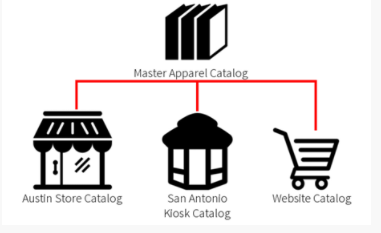Catalog Concepts
Learn about product catalog architecture and management
Watch: Creating a Catalog
See how to create a new catalog in Kibo
Types of Catalogs
There are two types of catalogs:- Master Catalogs: Specific to your tenant and contain all the products in your child catalogs that belong to them, which enables you to share products across all child catalogs.
- Catalogs: Specific to each of your sites or storefronts and only contain the products in them that you wish to sell in their associated storefronts.
Catalog Example
Imagine that your business includes a brick and mortar store in Austin, a kiosk in San Antonio, and a website, and you sell the following products:| Product | Location Available |
|---|---|
| Shirt | Austin store and website |
| Pants | Austin store and website |
| Skirts | Austin store and website |
| Sunglasses | San Antonio kiosk only |
| Bags | Austin store and website |

| Catalog Name | Catalog Type | Description |
|---|---|---|
| Master Apparel Catalog | Master catalog | Includes all of your products, including all the shirts, pants, skirts, sunglasses, and bags you sell. |
| Austin Store Catalog | Catalog | Includes a subset of all your products. You only sell shirts, skirts, pants, and bags in your Austin store. |
| San Antonio Kiosk Catalog | Catalog | Includes a limited subset of the products that you sell at your kiosk. You only sell sunglasses at the kiosk. |
| Website Catalog | Catalog | Includes a subset of all products that you sell online. You only sell shirts, pants, skirts, and bags on your website. |
Developer Reference
See the Admin Catalog API documentation for programmatic access

